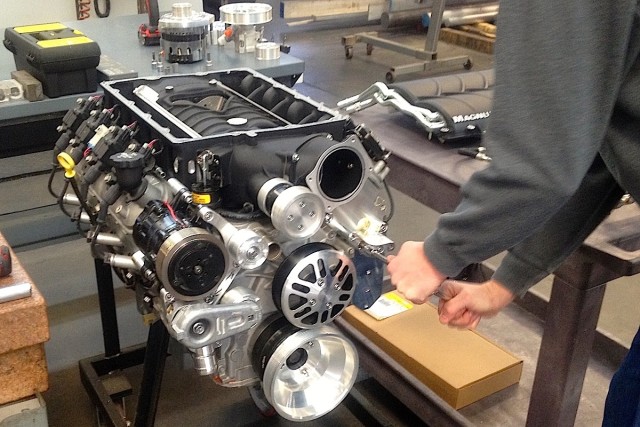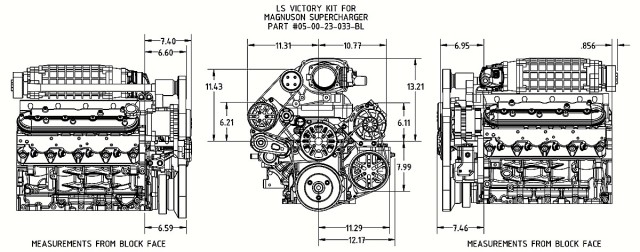The tallest hurdle in adding a supercharger to an LS engine project destined for a hot rod or early musclecar is usually the front accessory drive. Whether the engine is built from the ground up or starts with a crate long-block, adding a low-profile supercharger like those found in the Corvette ZR1 or ZL1 Camaro can test the builder’s patience when it comes to setting up the belt drive to turn that blower and other accessories. The frustration really builds when there are unforeseen clearance issues as the engine is dropped on the frame.
To solve those problems, Concept One expanded its LS front drive lineup to accommodate superchargers from Edelbrock, Whipple and Magnuson – including the latter’s new Heartbeat. There is also a kit for the LSA crate engine from Chevy Performance and an A/C compressor relocation kit for the LS9 engine; however, these pulley-and-belt kits are not targeted toward replacements on those factory engines.
The Concept One supercharger kits are intended more for hot rod and custom applications, rather than replacing factory systems on a stock vehicle.
It can take 40 or more horsepower to turn those superchargers, and that puts a lot of stress on the brackets. – Kevin Redd, Concept One
Whether for a street rod, custom truck or classic musclecar, the LS engine is a popular choice due to its availability and widespread acceptance in the aftermarket. It also accepts compact superchargers relatively easily as there are numerous bolt-on kits designed to complement the engine’s fuel system and compression ratio as well as adapt to a variety of engine-management computers. Think of all the options:
- Get an assembled long-block from a Chevy Performance Parts dealer and pick the supercharger that fits your budget and power needs
- Build a LS engine from scratch or start with a crate short-block and add the desired heads, supercharger and fuel system
- Source a used engine from the classifieds or salvage yard, clean it up and install the supercharger
They’re all relatively hassle-free choices for any custom build, except when trying to piece together or fabricate the front accessory drive. Many of the problems stem from correctly matching the pulley sizes to drive the supercharger.
Concept One has kits for superchargers from GM, Edelbrock, Whipple and Magnuson. More on each system at the end of the story.
Concept One's Randy Redd is in charge of designing the pulley systems.
“Customers started asking about these kits three or four years ago, and we’ve been working on them since,” says Redd, noting the popularity of the supercharged factory cars from GM spurred interest in the trend. “A huge advantage of buying a complete pulley system is that the fit and ratios for the accessories have been engineered to work together.”
The Concept One supercharger kits feature the same general layout as the standard LS kits with the additional routing for the supercharger pulley.
Here's the difference between a stock LSA engine and one with the Concept One kit.
“We wanted to use as much as we could because we knew it would fit, clearance-wise,” adds Redd.
Factory LS engines generally mount the A/C compressors down low, but that location can become a clearance issue on many early musclecars.
“Our kits are built around moving the compressor up around the cylinder head,” says Redd. “The power-steering pump is pretty much in the original location.”
All of the brackets are CNC machined from billet aluminum.
However, there are some applications where the Concept One power-steering pump may bump up against a steering box or shaft. Also, some supercharger applications require a larger main pulley to provide adequate overdrive to the supercharger rotors.
“That did create some clearance issues with the power-steering,” explains Redd. “So, sometimes on front-steer cars, like a ’70 Camaro, we run a remote reservoir and move the pump up. The vehicle dictates which power-steering setup we go with.”
Getting the right fit
Concept One has helped solve hundreds of clearance problems with various LS engine combinations, so they have considerable feedback in a database to refer when working with a customer’s installation. The key, of course, is providing accurate details on the vehicle and any changes made, such as altering the suspension or steering.
Selecting The Right Finish
Concept One offers its accessory drive systems in four finishes; from left in the above photo: machined, polished, clear anodized and black anodized.
Here’s a closer look at each:
- Machined – naturally finished aluminum is the least expensive
- Polished – very attractive and bright but requires more maintenance
- Clear anodized – offers unique satin sheen and is low maintenance
- Black anodized – very durable hard coat that only requires basic cleaning
The C1 supercharger line also comes with an 8-rib, Goodyear Gatorback serpentine belt, which due to its thin construction helps dissipate heat more effectively.
“We definitely wanted an 8-rib for more grip turning those blowers,” says Redd. “At the time, we couldn’t get an 8- or 10-rib pulley for the compressor, only 6-rib. We had to design our own 8-rib compressor pulley to work with the clutch. Also, we have more options for belt length, compared to a 10-rib.”

Concept One expands its line of supercharger applications as new models hit the market. As this story was finished, the company was completing work on the new Magnuson Heartbeat supercharger.
The kits feature stronger brackets than a standard LS pulley system and a heavy-duty tensioner to handle the added torque produced by a blown engine.
“The standard brackets would flex when the supercharger kicked in,” says Redd. “It can take 40 or more horsepower to turn those superchargers, and that puts a lot of stress on the brackets.”
All of the supercharger pulleys are designed with the required offsets and size to support proper operation. Accessories can be customized, as well. Different flow rates and pressure-valve settings for the power steering pumps are available in addition to the different reservoir configurations. Regular and heavy-duty alternators are also offered in chrome or polished finishes, and the A/C compressor can be polished or chrome plated. Just discuss the options with the Concept One tech rep.
Following are closer looks at each of the supercharger systems from Concept One.
This kit is designed for the LSA engine, which can be purchased as a complete crate engine from Chevy Performance (PN 19260164) or pulled out of a salvage yard. GM also offers a LSA supercharger kit (PN 19244095) for retrofitting on to LS engines with the L92-style cylinder heads. The supercharger displaces 1.9 liters and uses twin Eaton 4-lobe, high-helix rotors. On a 6.2-liter engine it produces about nine pounds of boost. It includes an internal intercooler, and the GM kit comes with intake manifold, fuel injectors and throttle body.
To use the Concept One kit, the factory supercharger pulley must be replaced with a 10-bolt pulley hub (PN L250150309) from Lingenfelter Performance. This hub will facilitate quicker changes of pulley sizes, although the maximum recommended boost is 10 pounds.
 Edelbrock E-Force supercharger
Edelbrock E-Force supercharger
The Edelbrock bolt-on kit (PN 15410) is designed around Eaton Gen IV rotors and features 12-inch-long intake runners for improved low-end torque. The assembly includes a stand-alone intercooler with pump and recovery tank, fuel rails, injectors and plug-n-play harness. Edelbrock backs the system with an optional 5-year/100,000-mile warranty. This universal system works with LS3/L92 cylinder heads and the Gen V Camaro.
Concept One provides the 3.45-inch supercharger pulley and, again, recommends a maximum 10 pounds of boost.
This 2.9-liter twin-screw blower (PN WK-1000) features an oversized air-to-water intercooler and an intercooled bypass system that consumes less than one horsepower during cruising to help fuel economy. The kit was originally designed for the 6.2-liter Camaro engine, and the blower is available in wrinkle black or polish finish. It comes with 63-pound injectors and can be fitted with 102mm, 105mm or 112mm throttle body. The supercharger is designed with a self-contained oil system. Other features include quick-connect fittings and plug-n-play wiring.
Concept One provides 3.625-inch pulley with its kit, and recommended maximum boost is 10 pounds.
Magnuson MagnaCharger MP 2300
Available for LS1, LS2 and LS3 platforms, this supercharger kit (PN 05-00-033) displaces 2.3 liters – which is ideal for mid- to large-sized engines. It features a pair of Eaton TVS 4-lobe, high-helix rotors. Users can expect about a 40-percent boost in power with just by adding this supercharger. It also comes with an internal bypass valve to help improve fuel economy during normal driving conditions.
Magnuson Hearbeat supercharger
Desgined for the C6 Corvette, this low-profile front inlet/front-drive blower (PN 02-23-62-199-BL) also has the 2.3-liter displacement yet makes more horsepower than the Magnuson modular kit. It also weighs 17 pounds less than a standard TVS 2300 blower system. In independent tests at two different engine shops, the Heartbeat made more than 900 horsepower at 10 to 11 pounds of boost. The Heartbeat features an integrated intercooler with self-contained coolant system that has a Formula 1-style heat exchanger and internal bypass for improved fuel economy. The kit includes a cast-aluminum intake manifold, factory style push-lock connectors, high-flow fuel injectors, LS9 rail system and all necessary fittings and hardware.
Concept One is still finalizing kit details on the Heartbeat, so specific footnotes are not available yet. Contact the company for the latest information.
LS9 A/C compressor mount
While the Concept One supercharger applications are targeted toward aftermarket builds, the company does offer factory LS9 swaps a little more flexibility with a new A/C compressor mounting kit. Complete with brackets and Sanden SD-7 compressor, this kit replaces the factory unit and moves the compressor several inches closer to the engine. This provides more clearance if a supercharged LS9 engine is swapped into a musclecar or hot rod. It’s designed to work with the engine factory accessory system, including the 6-rib belt and stock LS9 oil pan. An example of a situation that requires this compressor relocation would be installing a LS9 into a Detroit Speed subframe for a Gen I Camaro.















































